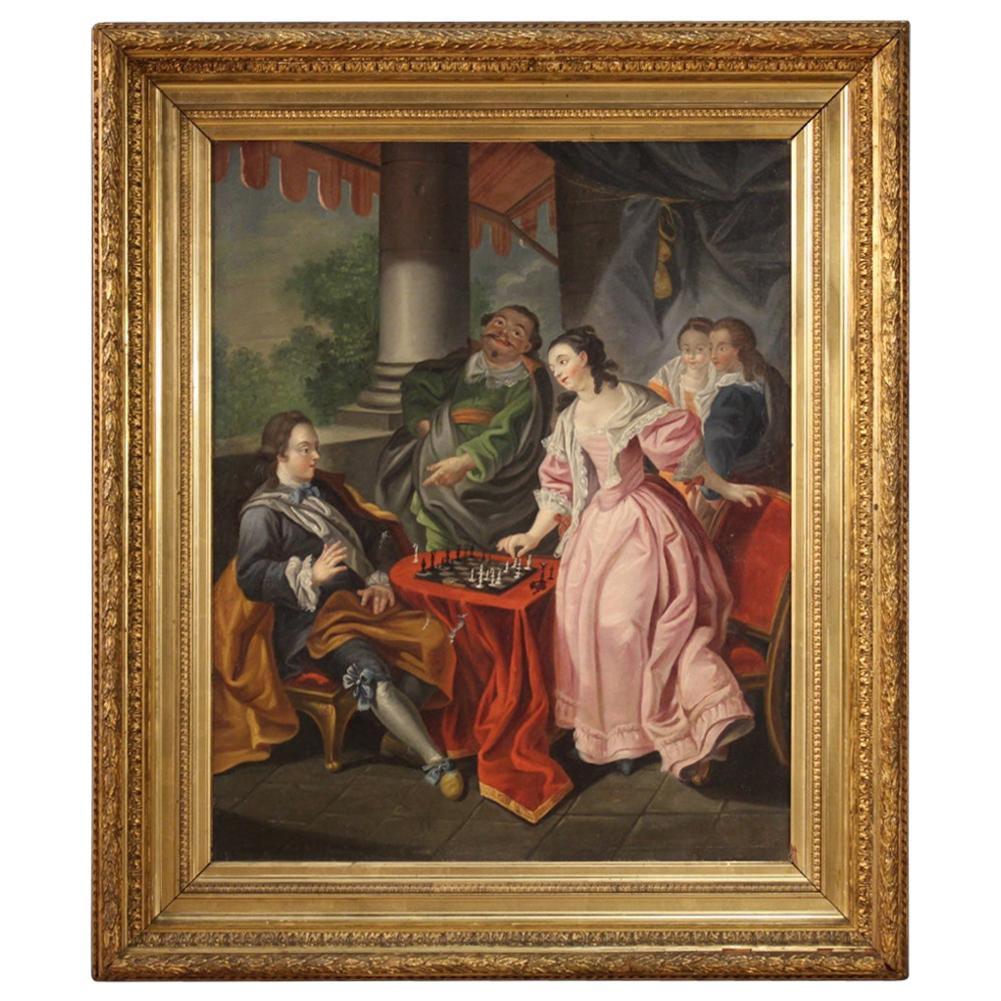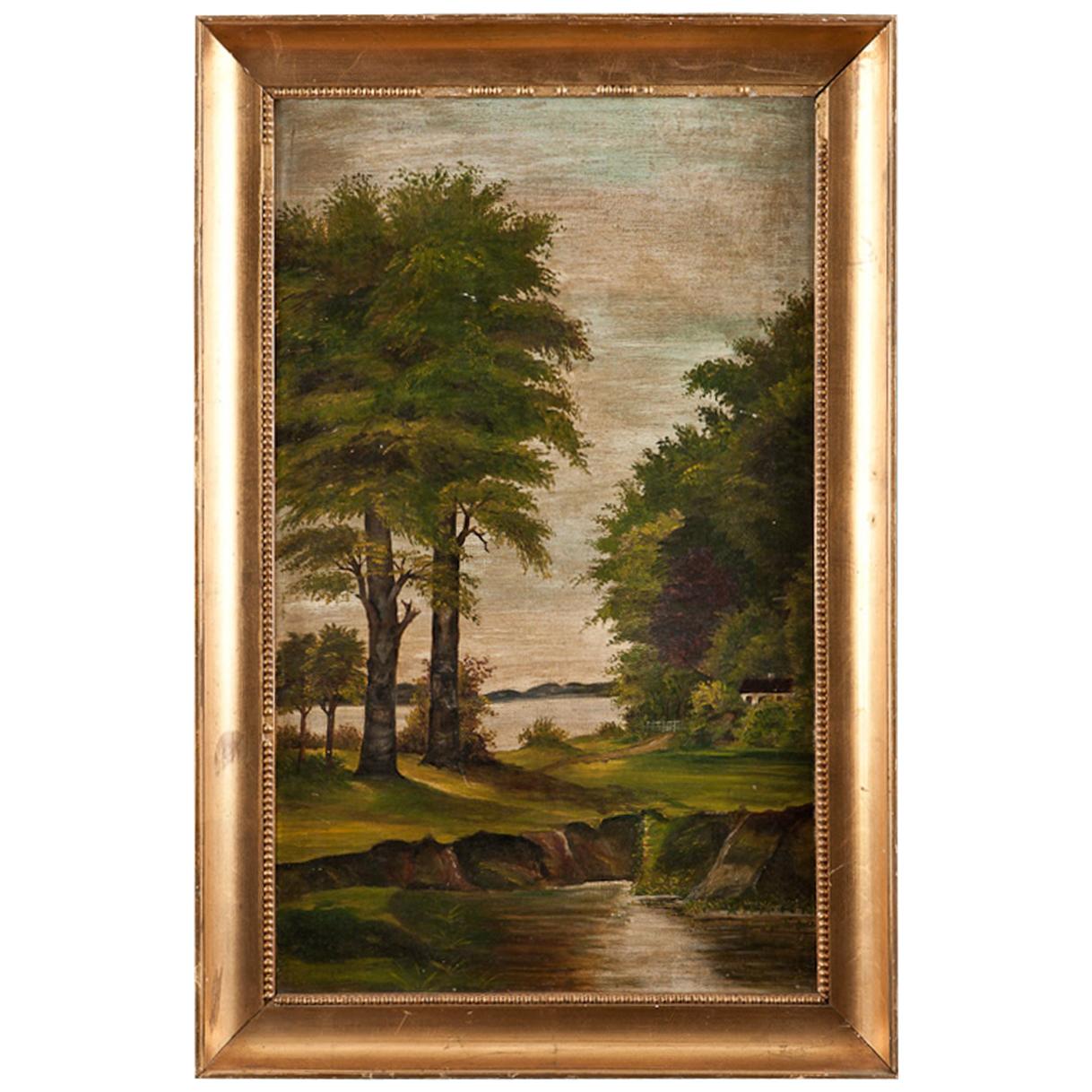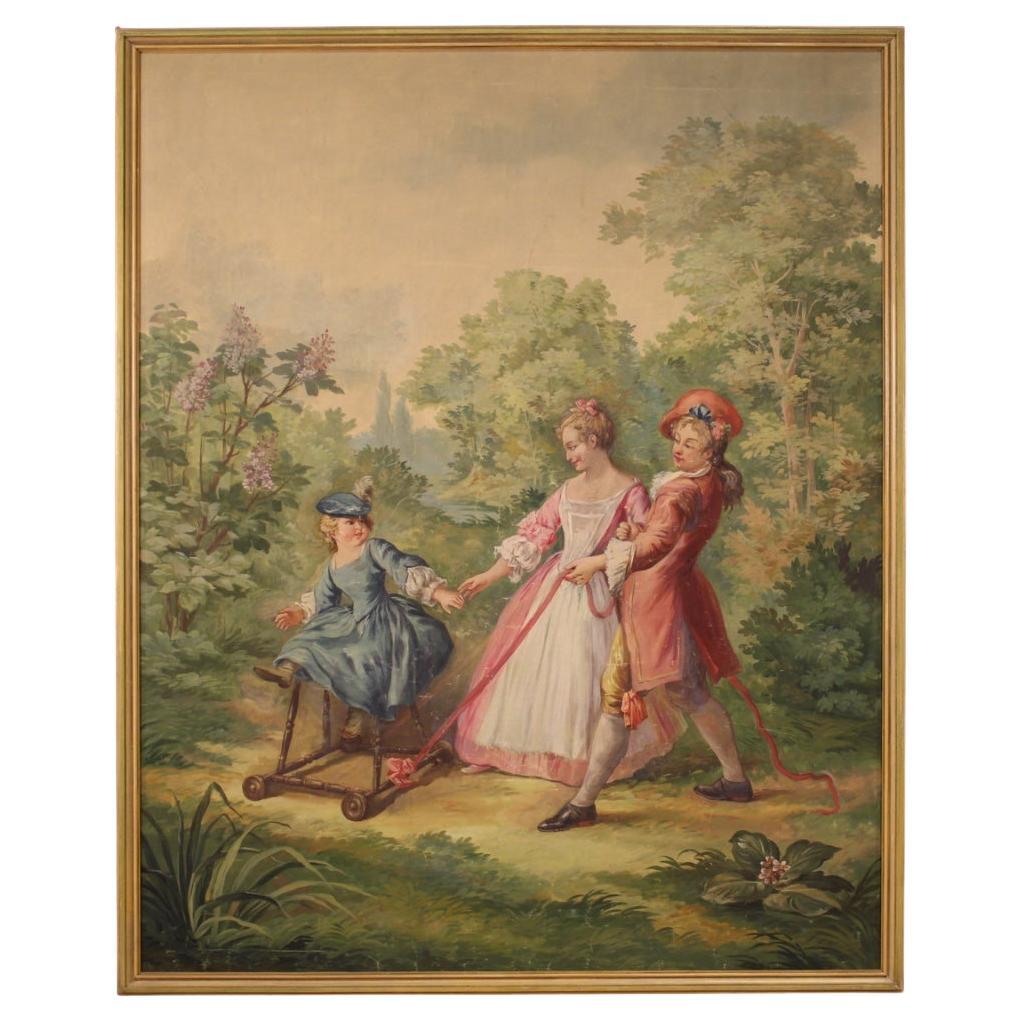Items Similar to Romantic French Oil on Canvas Painting
Want more images or videos?
Request additional images or videos from the seller
1 of 11
Romantic French Oil on Canvas Painting
About the Item
We kindly suggest you read the whole description, because with it we try to give you detailed technical and historical information to guarantee the authenticity of our objects.
20th Century romantic French oil on canvas painting signed F.Pauwels. Painted between 1947 and 1948. Measures cm.93x78 x5 with wood frame measures canvas cm. 60x75. For all our shipments we use special packaging materials (wooden crates, styrofoam, etc.) for maximum protection and safety of the objects.
- Dimensions:Height: 36.62 in (93 cm)Width: 30.71 in (78 cm)Depth: 1.97 in (5 cm)
- Style:Romantic (Of the Period)
- Materials and Techniques:
- Place of Origin:
- Period:
- Date of Manufacture:1947-1948
- Condition:Wear consistent with age and use.
- Seller Location:Prato, IT
- Reference Number:
About the Seller
5.0
Platinum Seller
These expertly vetted sellers are 1stDibs' most experienced sellers and are rated highest by our customers.
Established in 1977
1stDibs seller since 2019
234 sales on 1stDibs
Typical response time: 2 hours
- ShippingRetrieving quote...Ships From: Prato, Italy
- Return PolicyA return for this item may be initiated within 14 days of delivery.
More From This SellerView All
- Abstractism Geometric Style Painting Oil on Canvas, FranceLocated in Prato, TuscanyWe kindly suggest you read the whole description, because with it we try to give you detailed technical and historical information to guarantee the authenticity of our objects. Paint...Category
Mid-20th Century French Modern Paintings
MaterialsCanvas
- Abstractionism French Oil on Canvas Painting with Black FrameLocated in Prato, TuscanyWe kindly suggest you read the whole description, because with it we try to give you detailed technical and historical information to guarantee the authenticity of our objects. Paint...Category
Late 20th Century French Modern Paintings
MaterialsCanvas, Wood
- Napoleon III Style Large Oil On Canvas French Subject Calliope Gold BackgroundLocated in Prato, TuscanyWe kindly suggest that you read the entire description, as with it we try to give you detailed technical and historical information to ensure the authenticity of our objects. The fol...Category
Antique Late 19th Century French Napoleon III Paintings
MaterialsCanvas, Wood
- French Symbolic Expressionism Oil Painting Depicting French RevolutionLocated in Prato, TuscanyWe kindly suggest that you read the entire description, as with it we try to give you detailed technical and historical information to ensure the authenticity of our objects. Painting oil painting on canvas is made with mixed technique brush and spatula; the author used traditional brushes for a first draft giving shape to the whole drawing with an expert, loose wrist play and with sure and decisive brushstrokes; the representation, in this case, is not a pure exercise of virtuosity, in fact, the author communicates us his intimate essence manifesting it through the language of colors, shapes, and composition. The artist finished his work with the technique of spatula painting, named after the protagonist's instrument, redistributing the colors densely and consistently, making the painting take on a special body and depth. The painting is signed but we are unable to give definite information about the author, however, we confirm its extraordinary aesthetic and engaging vividness; the painting was made in 1989 in the author's studio in Paris whose intentions were to celebrate the 200th anniversary of the French Revolution (1789). The painter was inspired by both French Expressionism and Symbolism; Expressionism exalts the emotional value of art; it is the artist's desire to communicate inner feelings, while with Symbolism, painters tend to go beyond the objective representation of reality to focus instead on the subjective vision, in which inner feelings, emotions, and experiences are evoked above all. Our painting is overflowing with the symbolism of the French Revolution; it is practically an evocative essence of it. This important and overwhelming historical event is powerfully present in the soul of the artist who wanted to overbearingly communicate to us his deepest emotions by transposing them entirely in the painting with strong and vivid colors, he did not want to simply allude or hint but to express, indeed "shout" his own deep interiority. In his intentions, the painting schematically and symbolically represents a standard-bearer of the French Revolution wearing the classic "Phrygian" hat. The author used only the three colors white, red, and blue that characterized the flags of the French Revolution; they were the new banners, which opposed the traditional emblem of the monarchy, the lilies on a white field. Three were the colors because three were the goals of the Revolution: liberty, equality, and fraternity, and they represented the three classes into which French society of the time was divided: the clergy (blue), the nobility (white), and the third state (red). The "Phrygian" cap (Latin for pileus) painted in red in the painting also has a high symbolic value, In Roman times it was worn by the " freedmen" to show that they were now freed slaves but in the French Revolution it became the very symbol of Liberty; a similar cap was worn by the freed Marseilles convicts in 1792, and was the symbol of the Jacobins during the French Revolution. Due to this fact, in addition to its historical meaning of freedom, it was later adopted as a symbol of the revolution itself, a symbol immortalized on the "Marianne," the very emblem of France, in Eugène Delacroix's famous painting "Liberty Leading the People...Category
Late 20th Century French Modern Paintings
MaterialsCanvas, Wood
- Max Marra Painting Mixed Technique on Canvas, ItalyBy Max MarraLocated in Prato, TuscanyWe kindly suggest you read the whole description, because with it we try to give you detailed technical and historical information to guarantee the authenticity of our objects. Work of the famous Italian painter Max Marra, paint mixed technique on canvas dated 2004, titled "Judges"8, on the back of the painting we find a “Certificate of Authenticity”. Measures: cm 100 x 100 Max Marra was born in Paola, Calabria, in 1950. He lives in Monza and works in Lissone. Matured graphic and television experiences, from the 1980s he directed his research towards the integration of expressive technique in painting and sculpture with recycled materials. He works in the H: Orarte laboratory, which he shares with Mario De Leo. He links the teaching and commitment of cultural, organizational, and editorial promotion to artistic activity. With Mario De Leo, Luigi Bianco and other operators founded the Oason Movement in 1985 and then Harta, a bi-monthly cultural interaction, which was later joined by the Hartamotus Association. In 1988 he founded Lissone, with Mario De Meo, the interdisciplinary art studio H: Orarte, open to the consideration, dialogue, and confrontation of other artists, active in organizing cultural initiatives and events. His activity is linked to themes and specific cultural projects, identifiable in the contents and expressive tools. Strong hills, strong features, biting ideas, but also some stops in the white, which is air, which is infinite, to be captured in heavy frames, almost in a purification ritual. He exhibits in a personal exhibition in a private gallery, public institutions, participates in thematic exhibitions, and national and international collective exhibitions are present in Germany, France, Japan. Main exhibitions Cieli di terra, a cura di T. Coltellaro, Museo Archeologico, Lamezia Terme e Museo Civico d’Arte Contemporanea, Taverna, 2002; 57° Premio Michetti Laboratorio Italia, a cura di Philippe Daverio, Francavilla a Mare, 2006; Repubblica e costituzione: rassegna d’arte per i sessant’anni della costituzione italiana a cura di M. Domenicucci, F. Papale e C. Mosillo, Archivio Centrale dello Stato, Roma, 2008; Max Marra: Opere 1984-2009, Museo d’Arte Contemporanea di Lissone, 2009/10; Time passages, a cura di Omar Calabrese, Magazzini del Sale, Siena, 2011; Luoghi e realtà di ricerca tra identità e mutamento, a cura di T. Coltellaro, Collegio Sant’Adriano, San Demetrio Corone, 2011; Limen Arte vince il primo premio, Vibo Valentia, 2011; 54a Biennale di Venezia, Padiglione Italia per il 150° dell’Unità d’Italia “L’arte non è cosa nostra”, a cura di Vittorio Sgarbi, Sala del Re – Galleria Vittorio Emanuele II, Milano e Palazzo delle Esposizioni – Sala Nervi, Torino, 2011/12; Max Marra. Orizzonte senza approdo, a cura di C. Rizzi, Museo Parisi Valle, Maccagno, 2012; Cieli di cosmos, Sofia Arsenal, Museum for Contemporary Art, 2013; Equilibri materici, a cura di G. Bonomi, Centro per l’Arte Contemporanea, Rocca di Umbertide, 2015; E fu il terremoto, a cura di Vittorio Erlindo, Refettorio del Monastero di San Benedetto Po, Mantova, Monastero di Weingarten (Germania) 2018; IXION, MAC Lissone, a cura di A. Zanchetta; L’opera in bianco, a cura di S. Cortina, Galleria Cortina, Milano, 2018; Dal Rembrandt by himself all’io ritratto, a cura di G. Lepore, Accademia Nazionale delle Belle Arti di Sofia, Bulgaria 2018; Contributi al Novecento, Da Boccioni a Rotella ai contemporanei, Fondazione Stelline, Milano, a cura di B. Corà e T. Sicoli; Di studio in studio, Casa Museo Boschi Di Stefano, Milano, a cura S. Soddu, Comune di Milano e Politecnico di Milano 2019; Omaggio a Franca Rame, MusAlab Archivio Franca Rame e Dario Fò...Category
21st Century and Contemporary Italian Modern Paintings
MaterialsCanvas
- Max Marra Painting Mixed Technique on Canvas, ItalyBy Max MarraLocated in Prato, TuscanyWe kindly suggest you read the whole description, because with it we try to give you detailed technical and historical information to guarantee the authenticity of our objects. Work of the famous Italian painter Max Marra, paint mixed technique on canvas dated 2004, titled "Judges", on the back of the painting we find a “Certificate of Authenticity”, a photo of the author with signature and his biography, since the latter is written in Italian, we proceeded to translate it here below. Still, on the back of the picture, we can see two small repairs done by the author himself. Max Marra was born in Paola, Calabria, in 1950. He lives in Monza and works in Lissone. Matured graphic and television experiences, from the 1980s he directed his research towards the integration of expressive technique in painting and sculpture with recycled materials. He works in the H: Orarte laboratory, which he shares with Mario De Leo. He links the teaching and commitment of cultural, organizational, and editorial promotion to artistic activity. With Mario De Leo, Luigi Bianco and other operators founded the Oason Movement in 1985 and then Harta, a bi-monthly cultural interaction, which was later joined by the Hartamotus Association. In 1988 he founded Lissone, with Mario De Meo, the interdisciplinary art studio H: Orarte, open to the consideration, dialogue, and confrontation of other artists, active in organizing cultural initiatives and events. His activity is linked to themes and specific cultural projects, identifiable in the contents and expressive tools. Strong hills, strong features, biting ideas, but also some stops in the white, which is air, which is infinite, to be captured in heavy frames, almost in a purification ritual. He exhibits in a personal exhibition in a private gallery, public institutions, participates in thematic exhibitions, and national and international collective exhibitions are present in Germany, France, Japan. Main exhibitions Cieli di terra, a cura di T. Coltellaro, Museo Archeologico, Lamezia Terme e Museo Civico d’Arte Contemporanea, Taverna, 2002; 57° Premio Michetti Laboratorio Italia, a cura di Philippe Daverio, Francavilla a Mare, 2006; Repubblica e costituzione: rassegna d’arte per i sessant’anni della costituzione italiana a cura di M. Domenicucci, F. Papale e C. Mosillo, Archivio Centrale dello Stato, Roma, 2008; Max Marra: Opere 1984 – 2009, Museo d’Arte Contemporanea di Lissone, 2009/10; Time passages, a cura di Omar Calabrese, Magazzini del Sale, Siena, 2011; Luoghi e realtà di ricerca tra identità e mutamento, a cura di T. Coltellaro, Collegio Sant’Adriano, San Demetrio Corone, 2011; Limen Arte vince il primo premio, Vibo Valentia, 2011; 54a Biennale di Venezia, Padiglione Italia per il 150° dell’Unità d’Italia “L’arte non è cosa nostra”, a cura di Vittorio Sgarbi, Sala del Re – Galleria Vittorio Emanuele II, Milano e Palazzo delle Esposizioni – Sala Nervi, Torino, 2011/12; Max Marra. Orizzonte senza approdo, a cura di C. Rizzi, Museo Parisi Valle, Maccagno, 2012; Cieli di cosmos, Sofia Arsenal, Museum for Contemporary Art, 2013; Equilibri materici, a cura di G. Bonomi, Centro per l’Arte Contemporanea, Rocca di Umbertide, 2015; E fu il terremoto, a cura di Vittorio Erlindo, Refettorio del Monastero di San Benedetto Po, Mantova, Monastero di Weingarten (Germania) 2018; IXION, MAC Lissone, a cura di A. Zanchetta; L’opera in bianco, a cura di S. Cortina, Galleria Cortina, Milano, 2018; Dal Rembrandt by himself all’io ritratto, a cura di G. Lepore, Accademia Nazionale delle Belle Arti di Sofia, Bulgaria 2018; Contributi al Novecento, Da Boccioni a Rotella ai contemporanei, Fondazione Stelline, Milano, a cura di B. Corà e T. Sicoli; Di studio in studio, Casa Museo Boschi Di Stefano, Milano, a cura S. Soddu, Comune di Milano e Politecnico di Milano 2019; Omaggio a Franca Rame, MusAlab Archivio Franca Rame e Dario Fò...Category
21st Century and Contemporary Italian Modern Paintings
MaterialsCanvas
You May Also Like
- Romantic Painting, Oil on Canvas, Grazing Cows, Belgium 19th CenturyLocated in Greven, DEAntique romantic depiction of animals - oil on canvas. Painted in Belgium at the end of the 19th century. In the center we see two grazing cows next to farming equipment and in f...Category
Antique Late 19th Century Belgian Romantic Paintings
MaterialsCanvas
- 19th Century Oil on Canvas Antique French Painting Romantic Scene, 1880Located in Vicoforte, PiedmontGreat French painting from the second half of the 19th century. Work oil on canvas depicting landscape with nice "Romantic scene" with characters, of good painting hand and pleasing ...Category
Antique Late 19th Century French Paintings
MaterialsCanvas
- English Genre Painter, Romantic Scenery, Young Couple, Oil on CanvasLocated in Copenhagen, DKEnglish genre painter. Romantic scenery. Young couple. Oil on canvas. 19th century. In very good condition. The canvas measures 34 x 27 cm. The frame ...Category
Antique 19th Century English Romantic Paintings
MaterialsCanvas
- 18th Century Oil on Canvas French Romantic Painting The Game of Chess, 1780Located in Vicoforte, PiedmontAntique French painting from the late 18th century. Framework oil on canvas depicting a subject of romantic taste The game of chess, of excellent pictorial quality. Painting of nice ...Category
Antique 1780s French Paintings
MaterialsCanvas
- Scandinavian Romantic Oil on Canvas Unsigned "Riverscape with Trees", circa 1910Located in Miami, FLA romantic Scandinavian oil painting on canvas from the first quarter of the 20th century represents a "Riverscape with Trees". Dimensions: ...Category
Early 20th Century Scandinavian Romantic Paintings
MaterialsCanvas
- 20th Century Oil on Canvas Italian Romantic Scene Painting, 1920Located in Vicoforte, PiedmontGreat Italian painting from the first half of the 20th century. Oil on canvas framework with romantic subject Walk in the park of good pictorial quality. Painting that depicts a very pleasant scene, a young couple of parents with a child transported for...Category
Early 20th Century Italian Paintings
MaterialsCanvas
Recently Viewed
View AllMore Ways To Browse
French Safety
Vintage French Crate
Vintage French Crates
Vintage French Wooden Crates
Vintage French Wooden Crate
Painting Of Market Scene
Renaissance Period Paintings
French Country Painting Framed
Corcoran Gallery
Wall Truck
Vintage Autumn Decorations
Antique Horse Picture
Hughes Vintage Furniture
Italian Neoclassical Framed Painting
Antique Wall Swords
Antique Wood Picture Frames Wall
Equestrian Framed
Dutch Artwork




